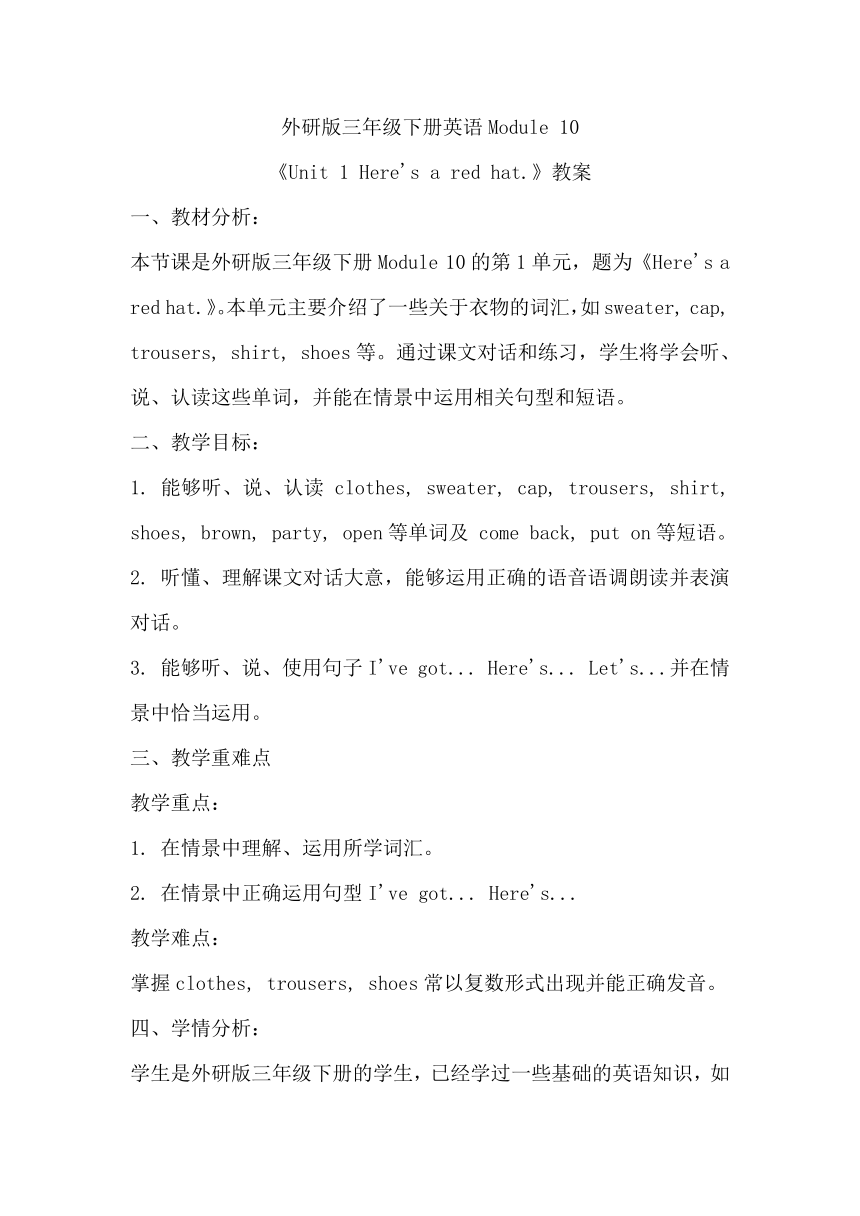
外研版三年级下册英语Module 10 《Unit 1 Here's a red hat.》教案 一、教材分析: 本节课是外研版三年级下册Module 10的第1单元,题为《Here's a red hat.》。本单元主要介绍了一些关于衣物的词汇,如sweater, cap, trousers, shirt, shoes等。通过课文对话和练习,学生将学会听、说、认读这些单词,并能在情景中运用相关句型和短语。 二、教学目标: 1. 能够听、说、认读 clothes, sweater, cap, trousers, shirt, shoes, brown, party, open等单词及 come back, put on等短语。 2. 听懂、理解课文对话大意,能够运用正确的语音语调朗读并表演对话。 3. 能够听、说、使用句子I've got... Here's... Let's...并在情景中恰当运用。 教学重难点 教学重点: 1. 在情景中理解、运用所学词汇。 2. 在情景中正确运用句型I've got... Here's... 教学难点: 掌握clothes, trousers, shoes常以复数形式出现并能正确发音。 四、学情分析: 学生是外研版三年级下册的学生,已经学过一些基础的英语知识,如基本的问候、数字、颜色等。他们对于新的单词和句型充满了好奇和探索的欲望。他们喜欢通过游戏和互动的方式来学习,并且能够较好地模仿和表演。 五、教学过程: Step 1: Warm-up a. Greet the students and engage them in a conversation about their favorite clothes. For example, "Good morning, class! What's your favorite color Can you tell me what clothes you like to wear " b. Show a variety of pictures of different clothes on the screen or using flashcards. Hold up each picture and ask the students to name the clothes and repeat after you. Encourage them to use descriptive words, such as colors or patterns, to describe the clothes. Step 2: Presentation a. Introduce the new vocabulary: clothes, sweater, cap, trousers, shirt, shoes. Show real objects or flashcards to help students understand the meaning of each word. Hold up each item and say its name, and have the students repeat after you. b. Use Total Physical Response (TPR) to teach the actions related to the clothes. For example, show a sweater and say, "Put on the sweater." Demonstrate putting on the sweater and ask the students to follow your actions. Repeat this process for other items of clothing. c. Teach the pronunciation of clothes, trousers, and shoes. Practice the words with the students, emphasizing the plural form and correct pronunciation. Break down the words into syllables and have the students repeat after you. Step 3: Listening and Speaking a. Play the audio of the dialogue in the textbook. Ask the students to listen carefully and try to understand the main idea of the conversation. b. Read the dialogue aloud and ask the students to repeat after you. Pay attention to the correct pronunciation and intonation. Encourage the students to use expressive facial expressions and gestures while speaking. c. Divide the students into pairs and provide each pair with a copy of the dialogue. Have them practice the dialogue with their partners, taking turns being the shopkeeper and the customer. Remind them to use the new vocabulary and expressions. Circulate among the pairs, offering guidance and assistance as needed. d. Invite some pairs to perform the dialogue in front of the class. Prov ... ...
~~ 您好,已阅读到文档的结尾了 ~~